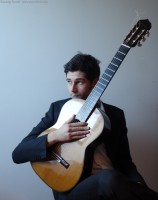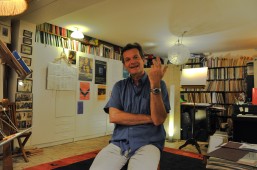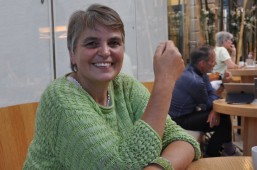
Playing and dancing - on ergonomically customized violas |
The method is based on movement. That’s how kids are spared from tenseness. A special method of viola construction further serves this goal.
Tina Strinning is a violist. She comes from a Swedish family and was born in Switzerland. Her roots are in the canton of Waadt, in Lavaux, a place she holds dear. Tina Strinning has performed a lot: Beyond playing in countless orchestras, she also founded the ensemble «Tamatakia» with three fellow musicians, exploring «World Music». She’s been a violin teacher at the Conservatoire de Lausanne for many years. Her teaching projects were so successful that she used to tour through all of Europe with her students. Tina Strinning has retired past September, dedicating her time exclusively to promote her teaching methods.
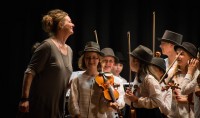
Mrs. Strinning, you have developed a unique teaching method for viola and violin. Can you tell us more?
The basic teaching tools I developed for instrumental learning, I call them «dancing violins». The main objective is to move while playing. It is a very effective, neurologically solid method: It is based on Jaques-Dalcroze’s method, which I adhere to. One practices the autonomy of gestures, which are the practical key with any instrument, and extends this autonomy through other movements. I told myself, if the initial process is more complicated, including feet, the students would eventually be able to free themselves of instrument related tension. And indeed, it works! So, I introduced the method to my students, in their first class; it was as if they had one more string under their bows.
I now offer courses for teachers, who would like to learn how to use this method. It isn’t normal to graduate from college without being able to play fundamental rhythmical exercises, or without being trained to feel the musical build. And still there are many who, just as me after graduating, are under the impression that they can only play behind a sheet music stand. What is the objective for a child to play? It needs to be a fun process, and our job is to teach them while they are having fun with sounds and music. Why is it that we force children to play sheet music behind a stand, if we could teach them to feel, to spend time alone with their instrument and create their own exercises?
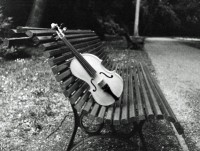
The Dalcroze-Method has opened these doors, and I feel it is my job to offer it to everybody. I have been teaching with a passion for almost 40 years, and I try to give the students my musical understanding in classical music, as well as in exploring the varied musical universes, while preparing them to a high artistic standard. Nowadays I spend my time traveling through Europe, teaching my method to teachers.
Please tell us more about the «Ministrings».
I founded «Les Ministrings» in 2002. The Conservatoire de Lausanne asked me to build an ensemble to prepare the students for the school orchestras; however, the project soon turned into something entirely different. We focus mainly on traditional music, which could be called «World Music». We also play Jazz and Swing (my assistant Baiju Bhatt, a Jazz violinist, contributes a lot in this relation). Key point is that the children stand on the stage alone. It is their show, and no adults interfere. Everything is played by heart, and there are improvisatory pieces. Performance is paired with dance. Thanks to our work, the «dancing violins» turns performances into choreographed shows.
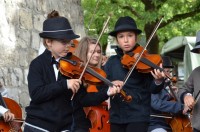
The performance works without any aids, for it is impossible to dance if standing behind a sheet music stand! However, it isn’t just the scenic aspect that makes the show. I’d say it is just the tip of the iceberg.
The level of the musical performance in this group is very high. The music alone is good enough to guarantee the show’s success. The project has become so successful that we needed to introduce an entrance exam, as so many kids wanted to participate.
We now have 30 kids, and it is important to us that participants can fully benefit. Last year we recorded a DVD and a CD with violinist Gilles Apap, in order to document the project’s first fifteen years. http://ministrings.ch/albums.php
You compose too…
Yes, I have written plenty of pieces for pedagogic purposes, all of which have appeared with Jonglor Editions and may be downloaded on my website. The works are also watched as videos. There are pieces and ensembles for all levels. http://www.jonglor.net/index.php
You use a specific instrument for viola students. What makes it unique?
It is a viola with three corners. One corner is missing. The side with the high strings is flattened, which simplifies playing high registers for children with small hands. The corpus is noticeably bigger on the side of the low strings: This supports the low resonances. At the same time, warmth, depth and volume of the sound are preserved. The children are still too small for a real viola, and it is important to limit their exposure to tension.
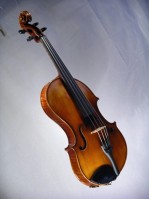
I let them start out on the violin, and once they are big enough, I suggest they switch to the viola. I then discovered the viola with three corners with the Colourstrings in Helsinki, where all ensemble members play on this type of instrument. When I returned, I noticed that this instrument was also very common in France. I then ordered the instruments for my students with Bernard Sabatier, a Paris based violin maker, and let John Trælnes in Lausanne customize each instrument for the kids. The kids love the viola with three corners; they find it funny, as it looks like a Dalì clock, or like a strange electric guitar. I let them start out on this instrument, until they are big enough for a 38 or 40 viola. The change usually happens between the age of 12 or 13.
Video examples:
« Pas de quoi », édition Jonglör, Mila sur un alto 3 coins: https://youtu.be/Dr0Bgj
« Prélude », édition Jonglör, duo pour alto et violon: https://youtu.be/F0g2-qcgxsE
« Violons Dansants », Sarah sur un alto 3 coins: https://youtu.be/fXBlszYVHa0
« Les Ministrings et Violons Dansants », https://youtu.be/lV-S3VQtoc4
« Les Ministrings swing», https://youtu.be/haUlR-y6Sao
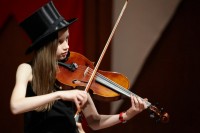
What are your next projects?
On March 30 2019 I will speak about ensemble music at the «European String Teachers Association» in Zürich, Switzerland. Thereafter I will go to Mexico for three weeks, to teach educators at two schools. Then there are multiple seminars with professors in Europe. After returning from our concert tour in Krakau in October 2018, «Les Ministrings» have plenty of upcoming concerts. In the summer I will lead a workshop for finalists of the Swiss Youth Music Competition.
Mrs. Strinning, thank you very much for the interesting interview!
Photos: Tina Strinning
2. Find the composer or work for which you want to write an input.
3. On the right side: click on «Write an input».
Pseudonym
Your input will only be published under your pseudonym. Under «My account» you can enter your pseudonym at any time.
| You may also be interested in |
In contrast to music school students, professionals need to explore the question of character and type: «Violists are less hurried, less competitive and aren’t looking for the spotlight... In the ensemble, violists take on the intermediary and connecting role», says Nicolas Corti, viola professor at the Zurich University for the Arts. » To the viola blog
The viola in music schools - A long awakened sleeping beauty
The specialist representative for violin and viola at the Music School Conservatory Zurich Ursula Schlatter, breaks any viola stereotypes right at the beginning of our conversation. Neither parents nor kids seem biased about the viola. » To the viola blog
|
|
 Visit and like us on Facebook.
Visit and like us on Facebook.» Music4Viola on Facebook
Viola news letter |
 Do you don't want to miss any news regarding viola anymore? Our monthly viola news letter will keep you informed.
Do you don't want to miss any news regarding viola anymore? Our monthly viola news letter will keep you informed.» Subscribe to our free viola news letter
Johann Nicolaus Triebel (-ca.1802)
Concerto Nr.3 F major, op. 55/3 for Viola and Orchestra
Published by: Wolfgang Birtel
